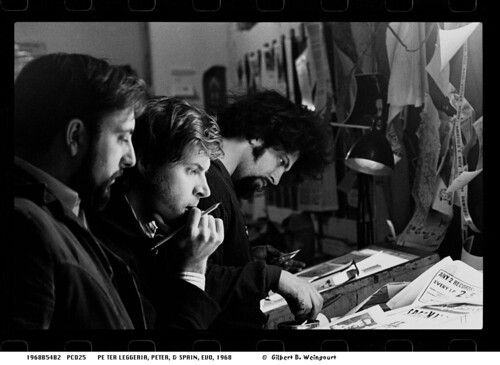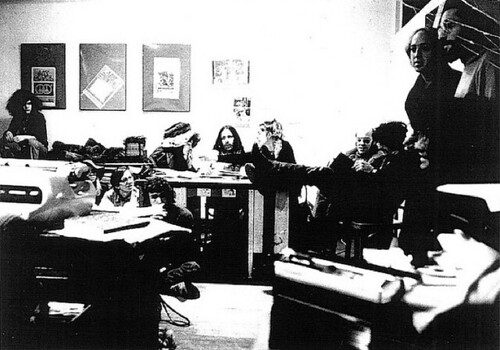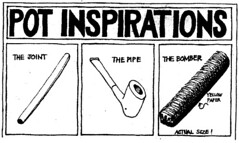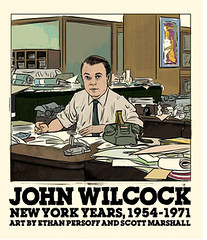Earlier this week, the Arthur L. Carter Journalism Institute launched “Blowing Minds: The East Village Other, the Rise of Underground Comix and the Alternative Press, 1965-72,” with a rousing discussion that’s now archived on the exhibit’s Website, along with new audio interviews with veterans of the Other. Over the course of seven weekend editions of The Local, we’ve heard from all but one of the EVO alumni who spoke on Tuesday’s panel. Here now, to cap off our special series, is the story of Peter Leggieri.
 Gil Weingourt Left to right: Peter Leggieri, Peter Mikalajunas, and Spain Rodriguez.
Gil Weingourt Left to right: Peter Leggieri, Peter Mikalajunas, and Spain Rodriguez.From the first day that I began working at The East Village Other, I was overcome by the sense that it was not only a newspaper but a strange and magical ship on a voyage with destiny. It seemed as though each issue printed was a new port of call, and the trip from one issue to the next, a new adventure. Many of EVO’s crew members expressed that same weird feeling – a sense of excitement and creative power.
And what a crew that was! No one was recruited. I don’t recall a resume ever being submitted. They all simply showed up and started working. EVO’s crew might just have been the greatest walk-on, pick-up team in the history of journalism. She was The Other but her staff of artists, poets, writers, photographers and musicians affectionately called her EVO. Her masthead bore a Mona Lisa eye. EVO created a cultural revolution and won the hearts and minds of a generation. She was the fastest ship in the Gutenberg Galaxy.
In the Beginning
I was the anonymous Other, the one editor-owner unknown to the public. I did not party. I did not schmooze with the literati or seek publicity. I had no time for such things. I worked seven days a week, 20 hours a day and, because of law school, I had to be sober. My friend, the poet John Godfrey, told me that I was afflicted with a Zen curse: a hermit condemned to be surrounded by people and events. That was certainly the case for me in the 1960s. Read more…
 Left to right: Steven Kohn, (on floor:) Heather, R. Crumb, Ray Schultz, (sitting behind:) Hetty Maclise, John Heys, Coca Crystal, Allen Katzman, David Walley, Little Arthur, (standing:) Joel Fabrikant, Jaakov Kohn
Left to right: Steven Kohn, (on floor:) Heather, R. Crumb, Ray Schultz, (sitting behind:) Hetty Maclise, John Heys, Coca Crystal, Allen Katzman, David Walley, Little Arthur, (standing:) Joel Fabrikant, Jaakov KohnThe end of my real involvement with The East Village Other came as something I perceived as a betrayal. I have come to think I really didn’t understand it at the time and perhaps what happened wasn’t directed at me personally. But sometimes I wonder.
I mentioned in my earlier piece that EVO was formed as a stock company, with Walter Bowart, Allen Katzman and I each owning three shares.
“We need to raise more money,” Walter said to me in the spring of 1966. “We’ve run out. I’ve called a meeting and there will be new people coming. We need to get more people buying stock.”
“It won’t dilute my one third, will it?” I asked.
“It doesn’t have to,” he said, “if you buy some more, too.” And this was technically true.
The meeting took place in our office on Avenue A on a Tuesday evening at 8 p.m. John Wilcock was there, a prized defector to The Other from the Village Voice, our designated competitor. I loved that idea. There were four new people in the room, none of whom was familiar to me, except for John.
“Okay, we’re here to buy stock,” Walter said. “Who’d like to go first?” Read more…
 Detail from an illustration by Bill Beckman.
Detail from an illustration by Bill Beckman.I came to EVO in late 1965. I think the paper was about three issues old. Walter Bowart had quit his job as a bartender at the Dom on St. Marks Place (Ed Sanders says it was Stanley’s, maybe it was both) and had raised some money to publish what he was soon to become fond of calling “a hippie National Inquirer.” (“Hippies don’t like to read. They like pictures and big headlines.”) I had just come to New York City from Texas. At the time I wasn’t sure if I wanted to make it uptown or downtown. All that was certain was that I needed to get some kind of employment.
I was living in the basement of Bill and Debbie Beckman’s apartment on East Ninth Street between Avenues C and D. At the time, this was decidedly a sketchy neighborhood, populated by young Puerto Rican street entrepreneurs who would have duels with ripped-off car antennae, whipping each other viciously over turf or girlfriends or whatever. The old mittel Europeans, Ukrainians, and refugees who lived in the ratty tenements would scurry to get out of their way as they crossed Houston to get a knish. It would have been maybe December of 1965 when I arrived. It was shaping up as a very cold winter, with an incredible blizzard that happened just a few weeks after my arrival. Being a naive Texan, I had innocently driven my car and tried to keep it on the streets. I lost it for almost 10 days under the snow. It was all very new to me. Snow. Hippies. The East Village Other. Read more…
 Illustration: Ethan Persoff and Scott Marshall
Illustration: Ethan Persoff and Scott MarshallQ.
How did you know Walter Bowart?
A.
When I went to Japan to revise my book, “Japan on $5 a Day,” I had been dating Sherry Needham. When I returned, he was dating her.
Q.
Did you fight?
A.
Of course not. I was just worried that she wouldn’t fulfill her promise to bare a breast in the fourth picture of a story I wanted to tell in one of those-25 cent photo machines.
Q.
And did she?
A.
Yes, Walter came along and we had a high old time, assisted, as I remember, by the benevolent herb. Walter told me he was starting a new paper and I agreed to write for it. My first column was about how forgery had been a constant presence on the art scene for centuries. I called it “Art & Other Scenes” but Walter eliminated the “Art &.” The appearance of the column in EVO infuriated Ed Fancher [Village Voice founder and publisher] who insisted I choose between the two papers. Read more…








